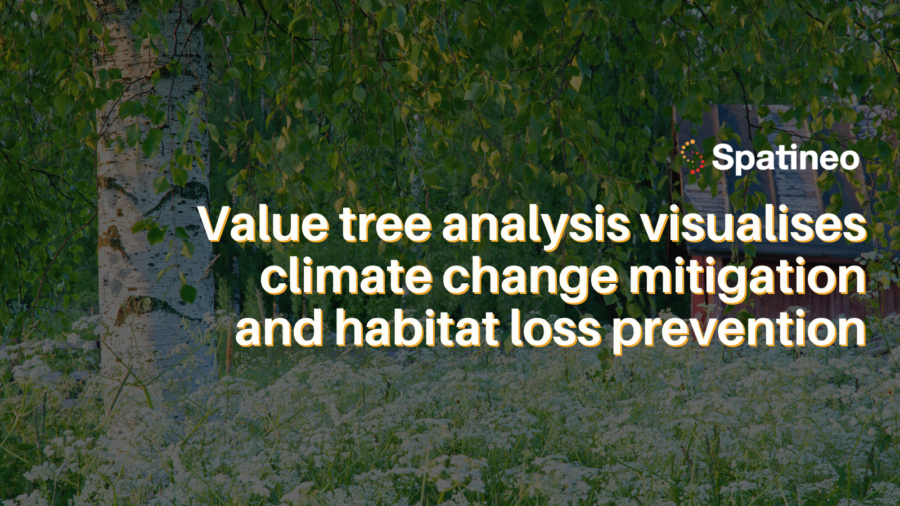Spatineo experts have been involved in the implementation of the management model in the project “Development of a common knowledge base for monitoring land use and its changes (Mammutti)”. As part of the management model, a value tree analysis of the spatial data products to be developed in the project was carried out.

“Mammutti”- project
To mitigate climate change and to achieve the Climate neutral Finland 2035 target, we need accurate and timely information on land use and its changes to support better reporting, planning, monitoring and decision-making. The joint project “Development of a common information base for monitoring land use and its changes (Mammutti)”, led by the Finnish Environment Institute and involving five organisations (Finnish Environment Institute, National Land Survey of Finland, Natural Resources Institute Finland, Finnish Forest Centre, Finnish Food Authority), will combine and further process the data produced by different actors into new spatial data products describing land use and its changes.
Value tree analysis
The impact and benefits of using the spatial data products produced by the “Mammutti” project for climate change management and biodiversity conservation was analysed through a so-called value tree analysis. The value tree analysis uses a visual representation to demonstrate and illustrate how spatial data products support the climate objectives of the land use sector. The value tree analysis provides an overall picture of how the objectives of the “Mammutti” project are being met, as well as how impactful the source data and spatial data products produced by the different actors are to climate change mitigation.
Data collection
Data for the value tree analysis was collected from project materials, interviews and a workshop. The collected materials allowed us to build a value tree and to infer the linkages between data providers, source data and the produced “Mammutti” spatial data products. In the interviews, interviewees identified use cases and benefits of using the spatial data products. The interviews included representatives from a wide range of user groups to ensure as comprehensive and diverse a view of use cases and benefits as possible. The interviews also helped to identify the linkages between use cases and benefits and the climate objectives. The workshop allowed the “Mammutti” project team to refine and complete the draft of the value tree with their expertise.
Formation of the value tree
The value tree was formed by Spatineo’s experts. In the value tree analysis, information providers and source data are linked to spatial data products, which in turn are linked to use cases and benefits enabled by the use of the spatial data products, which are then linked to the climate objectives of the land use sector.
The value tree contains six different levels: data providers, source data, spatial data products describing land use and its changes (“Mammutti” data products), use cases, benefits and targets.
Benefits and use cases
The interviews revealed that the benefits of using the “Mammutti” data products are related to reporting, planning, decision making and monitoring:
- More accurate and timely reporting will communicate progress towards climate targets.
- Better planning will support the achievement of climate objectives. In the planning process, off-the-shelf data products save users’ time and resources by eliminating the need to produce the data or combinations of data themselves.
- More accurate and up-to-date data products will support decision-making to achieve climate targets. In some cases, decisions would not be taken without these products.
- Comparable and up-to-date monitoring of changes will make the annual realisation of objectives against climate targets visible.
The targets supported by the use of the spatial data products are related to the objectives of climate measures in the land use sector and the maintenance of biodiversity. The use of “Mammutti” spatial data products is intended to mitigate climate change and its impacts, and to support the Climate neutral Finland 2035 objective. The impact of land use changes on biodiversity will also be monitored, planned and reported using “Mammutti” data products.
The targets under review in the “Mammutti” value tree are:
- Maintaining and enhancing carbon sinks and stocks in the short and long term.
- Reducing greenhouse gas emissions.
- Promoting adaptation to climate change.
- Promoting and maintaining biodiversity.
Results
The result of the value tree analysis was the “Mammutti” value tree. The value tree illustrates how knowledge flows from data providers through source data to “Mammutti” spatial data products. The data products support a wide range of use cases, realizing benefits that support climate objectives.
The “Mammutti” value tree. The value tree illustrates the linkage between data providers, source data, spatial data products, use cases, benefits and climate objectives.
The impact of the results of the analysis
The results of a value tree analysis are useful to a wide range of stakeholders: data providers, developers and users of data products, project promoters and investors. The analysis is particularly useful for the “Mammutti” project group, as it helps data providers, both experts and organisations, to see the wider impact of their work. The visualisation allows organisations to notice and assess which data are particularly used and valuable. In addition, the value chain can be used to identify gaps in knowledge, for example.
Value tree analysis also supports the discussion between knowledge providers and users by visualising the flow of information from source data to use cases and from there to wider benefits and objectives.
“The value tree analysis will be used in the future to develop the data sets produced by the project, to define the need for new data products based on the use cases already identified, and for the overall development of the data base for land use monitoring.”
-Elise Järvenpää, Finnish Environment Institute, coordinator of “Mammutti”- project
Our expert Isabel Donner gave a presentation on “Value tree analysis to support the evaluation of the impacts of “Mammutti” data products”. The recording of the webinar can be found on the Finnish Environment Institute’s youtube channel (in Finnish).

Want to stay updated?
-
How Modern Analytics Tools Improve Open Data Services
 Modern analytics tools can illuminate how geospatial APIs are used. They can reveal which services are most popular, what data is acquired through the API, the geographical areas of interest for those requests, and the origin of these requests. Additionally, they can monitor service availability, track downtimes, and identify performance […]
Modern analytics tools can illuminate how geospatial APIs are used. They can reveal which services are most popular, what data is acquired through the API, the geographical areas of interest for those requests, and the origin of these requests. Additionally, they can monitor service availability, track downtimes, and identify performance […] -
Spatineo Building NATO Standards Compliant Metadata Capability for the Finnish Defence Forces
 Ensuring good and efficient geospatial data management is crucial for successful training, planning and operations in the defence sector. The ability of NATO members to exchange geo-information in a secure and standards compliant way is key to successful and timely collaboration and building cross-national operational capability. Spatineo continued successful collaboration […]
Ensuring good and efficient geospatial data management is crucial for successful training, planning and operations in the defence sector. The ability of NATO members to exchange geo-information in a secure and standards compliant way is key to successful and timely collaboration and building cross-national operational capability. Spatineo continued successful collaboration […] -
New Age of Data Security: AI’s Role in Enhancing FTIA’s Digital Twins’ Cybersecurity
 Spatineo proudly facilitated the Finnish Transport Infrastructure Agency’s (FTIA) workshop, focusing on the future of digital twins and information security. The workshop aimed to innovate AI-based solutions to enhance the cybersecurity of digital twins. Leveraging Spatineo’s expertise in digital infrastructure and data flows, we explored FTIA’s innovative plans for digital […]
Spatineo proudly facilitated the Finnish Transport Infrastructure Agency’s (FTIA) workshop, focusing on the future of digital twins and information security. The workshop aimed to innovate AI-based solutions to enhance the cybersecurity of digital twins. Leveraging Spatineo’s expertise in digital infrastructure and data flows, we explored FTIA’s innovative plans for digital […] -
Spatineo and Elenia Join Forces to Create a Groundbreaking Digital Service: Capacity Map
 Spatineo developed an interactive electrical grid Capacity Map to simplify communication between Elenia, their project developers and customers.
Spatineo developed an interactive electrical grid Capacity Map to simplify communication between Elenia, their project developers and customers. -
Exciting News: Spatineo Inc. Awarded NRCan Tender for Geospatial Web Harvester Development and Operations
 We are thrilled to announce that Spatineo Inc. has been awarded both Stream 1 and Stream 2 of the tender by Natural Resources Canada (NRCan) for developing and operating the “Geospatial Web Harvester Development and Operations” project. The contract value is CAD 213 570.00. We are happy to continue working […]
We are thrilled to announce that Spatineo Inc. has been awarded both Stream 1 and Stream 2 of the tender by Natural Resources Canada (NRCan) for developing and operating the “Geospatial Web Harvester Development and Operations” project. The contract value is CAD 213 570.00. We are happy to continue working […] -
GIS & CYBER
 Cybersecurity in the Geospatial Industry is Still in its Infancy The headline might seem sensational, but there’s a good reason for it: Cybersecurity is on shaky ground when it’s not given enough thought, and the possibility of threats is not recognized or considered in service design and data handling. Information […]
Cybersecurity in the Geospatial Industry is Still in its Infancy The headline might seem sensational, but there’s a good reason for it: Cybersecurity is on shaky ground when it’s not given enough thought, and the possibility of threats is not recognized or considered in service design and data handling. Information […]
